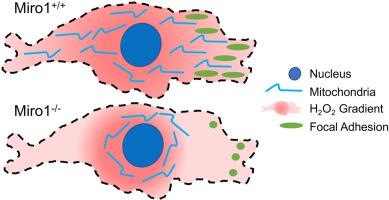Redox Biology ( IF 11.4 ) Pub Date : 2020-11-29 , DOI: 10.1016/j.redox.2020.101818 Haya Alshaabi 1 , Nathaniel Shannon 1 , Randi Gravelle 1 , Stephanie Milczarek 1 , Terri Messier 1 , Brian Cunniff 1

|
Mitochondria are strategically trafficked throughout the cell by the action of microtubule motors, the actin cytoskeleton and adapter proteins. The intracellular positioning of mitochondria supports subcellular levels of ATP, Ca2+ and reactive oxygen species (ROS, i.e. hydrogen peroxide, H2O2). Previous work from our group showed that deletion of the mitochondrial adapter protein Miro1 leads to perinuclear clustering of mitochondria, leaving the cell periphery devoid of mitochondria which compromises peripheral energy status. Herein, we report that deletion of Miro1 significantly restricts subcellular H2O2 levels to the perinuclear space which directly affects intracellular responses to elevated mitochondrial ROS. Using the genetically encoded H2O2-responsive fluorescent biosensor HyPer7, we show that the highest levels of subcellular H2O2 map to sites of increased mitochondrial density. Deletion of Miro1 or disruption of microtubule dynamics with Taxol significantly reduces peripheral H2O2 levels. Following inhibition of mitochondrial complex 1 with rotenone we observe elevated spikes of H2O2 in the cell periphery and complementary oxidation of mitochondrial peroxiredoxin 3 (PRX3) and cytosolic peroxiredoxin 2 (PRX2). Conversely, in cells lacking Miro1, rotenone did not increase peripheral H2O2 or PRX2 oxidation but rather lead to increased nuclear H2O2 and an elevated DNA-damage response. Lastly, local levels of HyPer7 oxidation correlate with the size and abundance of focal adhesions (FAs) in MEFs and cells lacking Miro1 have significantly smaller focal adhesions and reduced phosphorylation levels of vinculin and p130Cas compared to Miro1+/+ MEFs. Together, we present evidence that the intracellular distribution of mitochondria influences subcellular H2O2 levels and local cellular responses dependent on mitochondrial ROS.
中文翻译:

Miro1介导的线粒体定位支持亚细胞氧化还原状态
线粒体通过微管马达,肌动蛋白细胞骨架和衔接蛋白的作用策略性地遍及整个细胞。线粒体的细胞内定位支持亚细胞水平的ATP,Ca 2+和活性氧(ROS,即过氧化氢,H 2 O 2)。我们小组以前的工作表明,线粒体衔接蛋白Miro1的缺失会导致线粒体的核周聚集,从而使细胞外围缺乏线粒体,从而损害了周围的能量状态。在这里,我们报告说Miro1的删除大大限制了亚细胞H 2 O 2到核周间隙的水平,直接影响细胞对线粒体ROS升高的反应。使用遗传编码的H 2 O 2响应型荧光生物传感器HyPer7,我们显示亚细胞H 2 O 2的最高水平映射到线粒体密度增加的位点。用紫杉醇删除Miro1或破坏微管动力学可显着降低外周H 2 O 2含量。鱼藤酮抑制线粒体复合物1后,我们观察到H 2 O 2的峰值升高在细胞外围和线粒体过氧化物酶3(PRX3)和胞质过氧化物酶2(PRX2)的互补氧化。相反,在缺乏Miro1的细胞中,鱼藤酮不会增加外周H 2 O 2或PRX2的氧化,反而会导致核H 2 O 2的增加和DNA损伤反应的增加。最后,HyPer7氧化的局部水平与MEF中粘着斑(FAs)的大小和丰度相关,与Miro1 + / + MEFs相比,缺少Miro1的细胞粘着斑明显减少,并且纽蛋白和p130Cas的磷酸化水平降低。在一起,我们目前的证据表明线粒体的细胞内分布影响亚细胞H 2 O 2 水平和局部细胞反应取决于线粒体ROS。



























 京公网安备 11010802027423号
京公网安备 11010802027423号